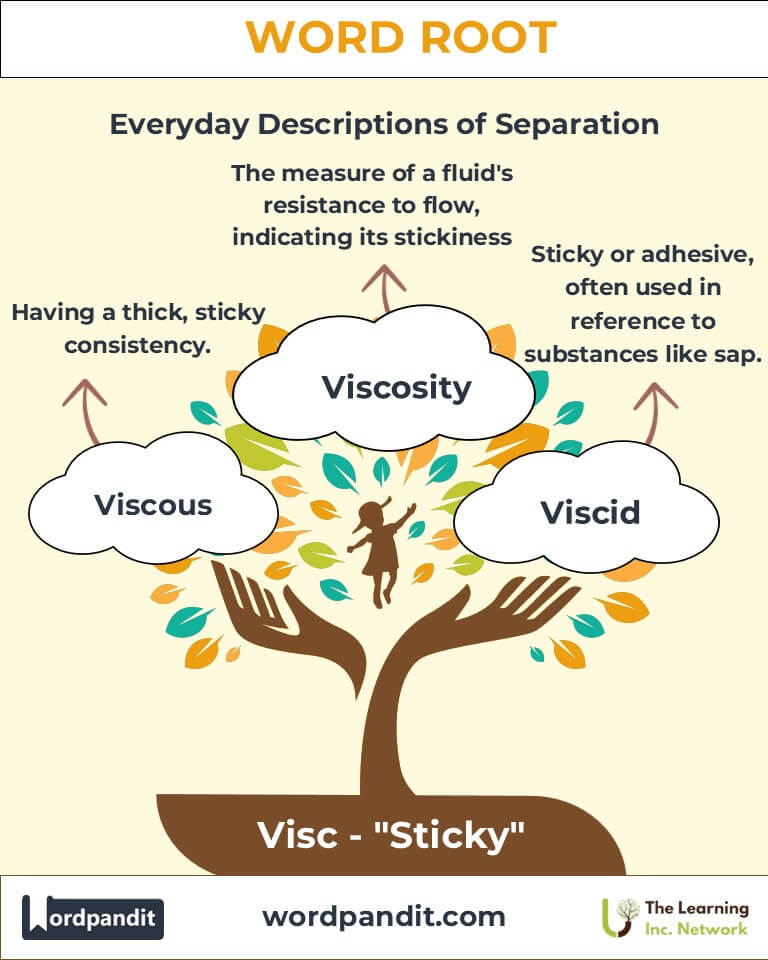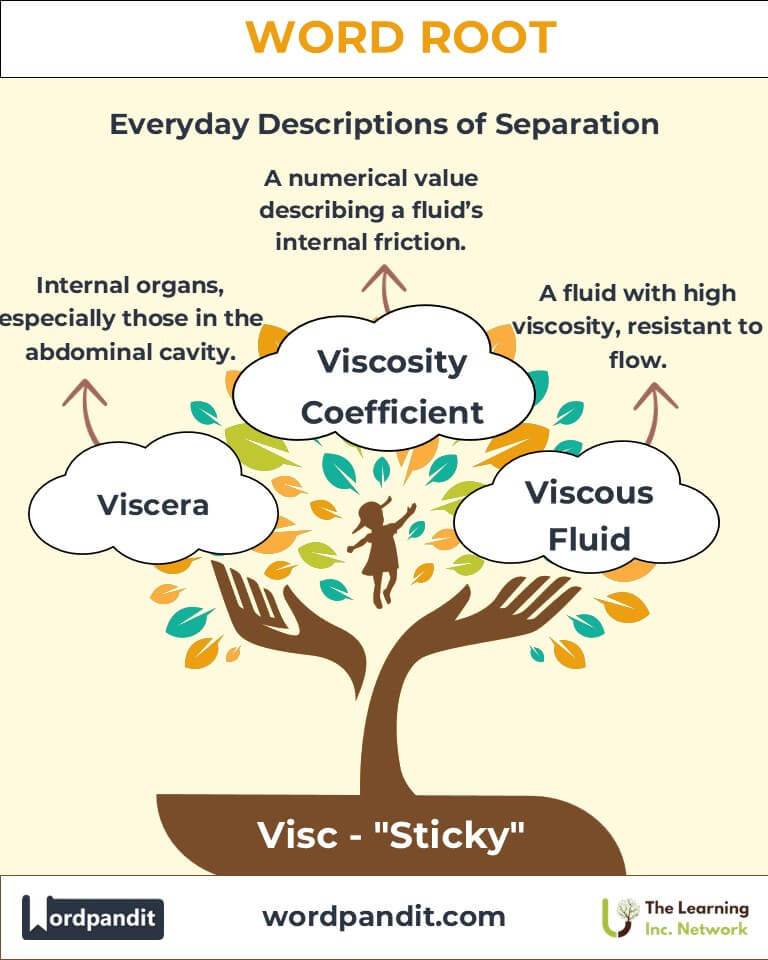Visc: The Sticky Root of Connection and Flow
Discover the fascinating world of the root "Visc", derived from Latin, meaning "sticky." From scientific applications like viscosity to everyday terms describing thickness and flow, this root underscores the dynamics of cohesion and adhesion in both language and nature.

Table of Contents
- Introduction: The Essence of Visc
- Etymology and Historical Journey
- Mnemonic: Unlocking the Power of Visc
- Common Visc-Related Terms
- Visc Through Time
- Visc in Specialized Fields
- Illustrative Story: Visc in Action
- Cultural Significance of the Visc Root
- The Visc Family Tree
- FAQs about the Visc Root
- Test Your Knowledge: Visc Mastery Quiz
- Conclusion: The Ever-Adhering Legacy of Visc
Introduction: The Essence of Visc
When you pour honey or stir paint, the sensation of resistance or thickness comes alive. This property, captured by the word "Viscous", is rooted in "Visc" (pronounced "visk"), meaning sticky. Originating from Latin, this root finds its way into scientific, industrial, and everyday contexts, describing substances that resist flow or bind together.

Etymology and Historical Journey
The root Visc originates from the Latin word viscum, referring to birdlime, a sticky substance derived from mistletoe berries. Over time, it evolved into terms describing thickness, resistance, and cohesion, like viscosity in physics and viscous in descriptive language.
Mnemonic: Unlocking the Power of Visc
Imagine a pot of honey dripping in slow, sticky ribbons. The image captures the essence of Visc—thick, sticky, and resistant to flow.
Mnemonic Device: "Visc is the stickiness that keeps things flowing slowly, like honey."
Common Visc-Related Terms
- Viscous: Having a thick, sticky consistency that resists flow.
Example: "The viscous syrup clung stubbornly to the spoon." - Viscosity: A measure of a fluid's resistance to flow.
Example: "Motor oil’s viscosity is crucial for engine performance." - Viscid: Sticky or adhesive in texture.
Example: "The tree's viscid sap stuck to his fingers." - Viscometer: A device used to measure the viscosity of a fluid.
Example: "The scientist used a viscometer to analyze the oil's properties." - Viscoelastic: A material property combining viscosity and elasticity.
Example: "Memory foam’s viscoelasticity makes it so comfortable."
Visc Through Time
- Viscum (Ancient): Used to describe birdlime, a sticky substance for trapping birds.
- Viscosity (Scientific Revolution): Adopted in the study of fluids to quantify resistance to flow.
- Modern Materials: Today, terms like viscoelasticity describe advanced polymers and materials combining flow and flexibility.
Visc in Specialized Fields
- Physics: Viscosity measures fluid resistance, crucial in studying flow dynamics, from lava to motor oils.
- Medicine: Viscoelastic solutions are used in eye surgeries or joint treatments.
- Material Science: Viscoelastic materials like memory foam revolutionize comfort and durability in products.
- Culinary Arts: Chefs consider the viscosity of sauces and syrups for texture and presentation.
Illustrative Story: Visc in Action
Sophia, a young scientist, studied the viscosity of different oils to create an eco-friendly lubricant for wind turbines. She tested each sample with a viscometer, observing how the most viscous blends resisted flow under pressure. Her innovation, inspired by nature’s resilience, paved the way for sustainable energy solutions.
Cultural Significance of the Visc Root
Stickiness often symbolizes connection and resilience. In literature, metaphors like “sticky situations” or “binding relationships” reflect Visc’s broader implications. Historically, birdlime (viscum) represented both a tool for survival and a challenge to freedom.

The Visc Family Tree
- Adhes (Latin: "stick to"): Adhesive: A substance used for sticking.
- Glut (Latin: "glue"): Glutinous: Sticky or glue-like.
- Tack (Old English: "fasten"): Tacky: Slightly sticky to the touch.

FAQs About the Visc Root
Q: What does the root "Visc" mean?
A: The root "Visc" comes from the Latin viscum, meaning "sticky." It represents the properties of cohesion or adhesion, often seen in fluids and materials that resist flow or bind surfaces together.
Q: How does Viscosity relate to the root "Visc"?
A: Viscosity is a measure of how resistant a fluid is to flow, capturing the essence of stickiness from the root "Visc." High-viscosity fluids, like honey, flow slowly due to internal friction, while low-viscosity fluids, like water, flow more freely.
Q: Is there a difference between "Viscous" and "Viscid"?
A: Yes. While both words relate to stickiness, “viscous” often describes the flow resistance of liquids, such as syrup or oil. “Viscid,” on the other hand, typically applies to semi-solid or sticky substances like sap or glue.
Q: What is a Viscometer, and why is it used?
A: A viscometer is a device used to measure a liquid's viscosity. It’s critical in industries like oil production, food manufacturing, and pharmaceuticals to ensure products meet specific consistency and performance standards.
Q: What does "Viscoelastic" mean, and where is it applied?
A: Viscoelastic materials have both viscous (flow-like) and elastic (spring-like) properties. These are commonly found in memory foam, rubber, and biological tissues. Such materials are crucial in fields like medicine, construction, and product design.
Test Your Knowledge: Visc Word Root Quiz
1. What does the root "Visc" mean?
2. What is measured by a Viscometer?
3. Which term combines properties of stickiness and elasticity?
4. What does "Viscous" describe?
5. Which of the following substances is the most viscous?
Conclusion: The Ever-Adhering Legacy of Visc
From describing the thickness of honey to the elasticity of polymers, "Visc" exemplifies the essence of connection and resistance. Its legacy spans scientific, industrial, and everyday realms, proving the enduring relevance of this sticky root. Let Visc remind you of the unseen forces binding and flowing through our world.












